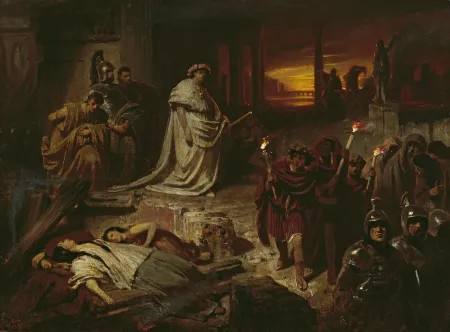West of the Coliseum, now sponsored by shoe manufacturer Diego Della Valle, who has donated $34 million to its restoration, sprawl the imperial ruins of the Palatine Hill. Here on April 11, 2011 the Special Superintendence for Rome’s Archaeological Heritage opened an exhibit devoted to the Emperor Nero. On display for the first time were Nero’s many architectural and cultural contributions, including a recently excavated chamber believed to be the legendary coenatio rotunda, a rotating dining hall with sweeping views onto the Alban Hills.
Any show about the notorious Nero was bound to attract visitors, but the superintendence had not anticipated its greatest turnout in a decade. Movie stars, fat cats, and politicians mobbed the exhibit, including Prime Minister Silvio Berlusconi, accompanied by a bevy of sequined bimbos. The bright lights revealed the flaws in his face lift, but the prime minister kept smiling at the cameras.
“Well, he’s good box office,” observes Roberto Gervaso, the bald and hawk-eyed 77-year-old author of the 1978 biographical novel Nerone. Did Gervaso mean Nero or Berlusconi? The old man laughed at the reporter’s question. “Nero, of course! They’ve made lots of films about Nero, but they couldn’t resist making a caricature of him. There’s no need to do that—he was a caricature himself.”
Nero Claudius Caesar Augustus Germanicus, the last of the Julian-Claudian dynasty, was Rome’s greatest showman. Only seventeen when he became emperor, he remained a narcissist and an exhibitionist. He drove chariots, strummed the lyre, and recited poetry. If he had been alive today, he would have entered talent contests, haunted karaoke bars, or posted You Tube clips. Instead, he hijacked Rome’s entertainment complexes, such as the Circus Maximus, which seated between 150,000 and 180,000 spectators, and inflicted his hamming on the Senate and people. Nero turned Homer into air guitar, danced classical Greek ballet (despite spindly legs and a pot belly), and played gods and heroes and even heroines and goddesses in campy adaptations of Aeschylus and Sophocles.
“While he performed,” Suetonius reports, “no one was allowed to leave the theatre even for the most urgent reasons. And so it is said that some women gave birth to children there, while many who were worn out with listening and applauding, secretly leaped from the wall, since the gates at the entrance were closed, or feigned death and were carried out as if for burial.”
Nero dreaded that he was making a fool of himself. To preempt ridicule, he turned his enemies and subjects into laughingstocks. He compelled 400 senators and 600 knights to fight in the arena. He ordered charioteers to race with donkeys and camels. He forced acrobats to perform daredevil parodies of Greek myth. An unlucky Icarus fell too close to the imperial couch and bespattered the emperor with blood. He cast a Cretan ballerina as Pasiphae, made her squeeze into a wooden heifer, and had her mounted by a bull. Christians, of course, he dressed as scarecrows and set on fire.
The plebs did not know how to react to these spectacles, so Nero created claques. He selected 5,000 hunky youths, easily recognizable by their bushy hair and spangled gowns, and divided them into three groups. The Bees made a loud humming sound. The Roof Tiles clapped with their hollowed hands; the Bricks, flat-handed. Whenever the crowds were confused by the sight of naked pregnant women fighting like gladiators, the claque cued them to laugh and applaud. No dead air in Nero’s arena. He was a terrible emperor but a wonderful program director.
Nero never owned a television network. Nevertheless, he awarded himself an Emmy the size of the Statue of Liberty. He erected a 100-foot bronze colossus of himself in the vestibule of the Domus Aurea or Golden House. Supposedly, the Emperor had set fire to Rome to make room for this vast complex, spanning the north side of the Palatine, across the Velian ridge to the Esquiline Hill. Standing outside the main entrance at the end of the Appian Way in a large atrium of porticoes, the statue held a rudder on a globe, symbolizing Nero’s power over land and sea.
Such extravagance antagonized the Senate and alienated the provinces. When the armies rebelled in Gaul and Hispania and marched on Rome, the carnival was over. Before being dispatched by his secretary, the emperor cried, “Qualis artifex pereo!” What an artist dies in me! The Senate declared Nero anathema and erased his name from monuments, but the populace mourned him. He had provided so much free entertainment.
Nero’s more prudent successors capitalized on this nostalgia. Vespasian added a sun-ray crown to his statue and renamed it Colossus Solis, after the Roman sun god Sol. Hadrian later moved the landmark to make room for the Temple of Venus and Roma. Two dozen elephants hauled the colossus northwest from the Domus Aurea to the Flavian Amphitheater, renamed the Coliseum in its honor.
Two thousand years later, at the Archeological Heritage’s mixer on the Palatine, modern Romans pondered Nero’s legacy. Count Andrea Carandini, professor of archeology at Sapienza University, warmed to the subject. Nero turned myth into politics, politics into spectacle. The Roman games became bloody and mindless mass entertainment: a distraction from drudgery and oppression, a safety valve for frustration and resentment. They provided the only direct communion between rulers and the masses, who were no longer free citizens but a captive audience. “This is television!” Carandini exclaimed. “Silvio Berlusconi did exactly the same thing, using the media to connect with the plebs.”
Walter Vetroni, Rome’s former mayor, who once served as Italy’s minister of culture, rejected the comparison. Whatever his faults, Nero at least had appreciated archeology. “Berlusconi, in contrast, has no interest in archeology,” Vetroni said. “The word is simply not in his head.”

